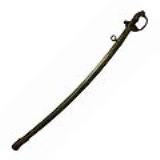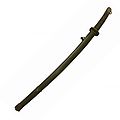
Shin gunto
Encyclopedia
The was a weapon and badge of rank used by the Imperial Japanese Army
between the years of 1935 and 1945. During most of that period, the swords were manufactured at the Toyokawa Naval Arsenal
.

scabbard.
In response to rising nationalism within the armed forces, a new style of sword was designed for the Japanese military in 1934. The shin guntō was styled after a traditional slung tachi of the Kamakura period
(1185-1332). Officers' ranks were symbolized by coloured tassles tied to a loop at the end of the hilt. The corresponding colors were brown/red & gold General; brown & red field officer; brown & blue company or warrant officer; brown sergeant, sergeant major or corporal.
sword replaced the western style kyu gunto in 1934. It had a traditionally constructed hilt
(tsuka) with ray skin (same) wrapped with traditional silk wrapping (ito). A cherry blossom (a symbol of the Imperial Japanese Army
) theme was incorporated into the guard (tsuba), pommels (fuchi and kashira) and ornaments (menuki).
The scabbard (saya) for the Type 94 was made of metal with a wood lining to protect the blade. It was often painted brown and was suspended from two brass mounts, one of which was removable and only used when in full dress uniform. The fittings on the scabbard were also decorated with cherry blossom designs.
The blades found in "Type 94" shin guntō ranged from modern machine made blades through contemporary traditionally manufactured blade to ancestral blades dating back hundreds of years.
s (NCOs). It was designed to resemble an officer's shin guntō but be cheaper to mass produce. All NCO swords had machine made blades with deep fullers
(bo hi) and a serial number stamped on the blade in arabic numerals
. Initially the hilts (tsuka) were cast out of metal (either copper or aluminum) and painted to resemble the traditionally produced items on the officer's swords. They had brass guards similar to the officer's shin guntō.
By 1945 a simplified NCO sword was being produced. It had a simple wooden hilt with cross hatched grooves for grip. The scabbards were made from wood instead of metal and the guard and other fittings were made from iron instead of brass.
Many changes occurred to the "Type 98" between 1938 and the end of the war in 1945. Late in the war Japan's supply of metal was drying up and shin guntō were produced with painted wooden scabbards, and with cheaper or no brass ornamentation. Some of the final swords produced in the last year of the war utilized cheap copper or blackened iron fittings.
Imperial Japanese Army
-Foundation:During the Meiji Restoration, the military forces loyal to the Emperor were samurai drawn primarily from the loyalist feudal domains of Satsuma and Chōshū...
between the years of 1935 and 1945. During most of that period, the swords were manufactured at the Toyokawa Naval Arsenal
Toyokawa Naval Arsenal
The was a major production facility for aviation ordinance, light arms, and ammunitions for the Imperial Japanese Navy during World War II. It was located in what is now part of the city of Toyokawa), Aichi Prefecture, Japan...
.

Creation of a new army sword
Until 1934 the standard sword of the Japanese military was known as the kyū guntō old military sword. The kyū guntō closely resembled European and American swords of the time, with a wraparound hand guard (also known as a D-Guard) and chrome platedChrome plating
Chrome plating, often referred to simply as chrome, is a technique of electroplating a thin layer of chromium onto a metal object. The chromed layer can be decorative, provide corrosion resistance, ease cleaning procedures, or increase surface hardness.-Process:A component to be chrome plated will...
scabbard.
In response to rising nationalism within the armed forces, a new style of sword was designed for the Japanese military in 1934. The shin guntō was styled after a traditional slung tachi of the Kamakura period
Kamakura period
The is a period of Japanese history that marks the governance by the Kamakura Shogunate, officially established in 1192 in Kamakura by the first shogun Minamoto no Yoritomo....
(1185-1332). Officers' ranks were symbolized by coloured tassles tied to a loop at the end of the hilt. The corresponding colors were brown/red & gold General; brown & red field officer; brown & blue company or warrant officer; brown sergeant, sergeant major or corporal.
Type 94
officersOfficer (armed forces)
An officer is a member of an armed force or uniformed service who holds a position of authority. Commissioned officers derive authority directly from a sovereign power and, as such, hold a commission charging them with the duties and responsibilities of a specific office or position...
sword replaced the western style kyu gunto in 1934. It had a traditionally constructed hilt
Hilt
The hilt of a sword is its handle, consisting of a guard,grip and pommel. The guard may contain a crossguard or quillons. A ricasso may also be present, but this is rarely the case...
(tsuka) with ray skin (same) wrapped with traditional silk wrapping (ito). A cherry blossom (a symbol of the Imperial Japanese Army
Imperial Japanese Army
-Foundation:During the Meiji Restoration, the military forces loyal to the Emperor were samurai drawn primarily from the loyalist feudal domains of Satsuma and Chōshū...
) theme was incorporated into the guard (tsuba), pommels (fuchi and kashira) and ornaments (menuki).
The scabbard (saya) for the Type 94 was made of metal with a wood lining to protect the blade. It was often painted brown and was suspended from two brass mounts, one of which was removable and only used when in full dress uniform. The fittings on the scabbard were also decorated with cherry blossom designs.
The blades found in "Type 94" shin guntō ranged from modern machine made blades through contemporary traditionally manufactured blade to ancestral blades dating back hundreds of years.
Type 95
released in 1935 was designed for use by non-commissioned officerNon-commissioned officer
A non-commissioned officer , called a sub-officer in some countries, is a military officer who has not been given a commission...
s (NCOs). It was designed to resemble an officer's shin guntō but be cheaper to mass produce. All NCO swords had machine made blades with deep fullers
Fuller (weapon)
A fuller is a rounded or beveled groove or slot in the flat side of a blade . A fuller is often used to lighten the blade, much in the way that an I-beam shape allows a given amount of strength to be achieved with less material...
(bo hi) and a serial number stamped on the blade in arabic numerals
Arabic numerals
Arabic numerals or Hindu numerals or Hindu-Arabic numerals or Indo-Arabic numerals are the ten digits . They are descended from the Hindu-Arabic numeral system developed by Indian mathematicians, in which a sequence of digits such as "975" is read as a numeral...
. Initially the hilts (tsuka) were cast out of metal (either copper or aluminum) and painted to resemble the traditionally produced items on the officer's swords. They had brass guards similar to the officer's shin guntō.
By 1945 a simplified NCO sword was being produced. It had a simple wooden hilt with cross hatched grooves for grip. The scabbards were made from wood instead of metal and the guard and other fittings were made from iron instead of brass.
Type 98
The change to occurred in 1938 and was essentially a simplification of the "Type 94". There were only minor differences between early "Type 98" swords and the "Type 94" swords that preceded them. Most notably the second (removable) hanging point was deleted from the scabbard.Many changes occurred to the "Type 98" between 1938 and the end of the war in 1945. Late in the war Japan's supply of metal was drying up and shin guntō were produced with painted wooden scabbards, and with cheaper or no brass ornamentation. Some of the final swords produced in the last year of the war utilized cheap copper or blackened iron fittings.

